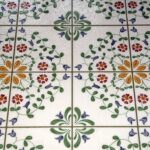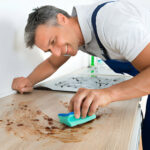
Your outdoor living spaces can be made into cozy retreats with the addition of outdoor cushions and pillows. But, over time, exposure to the elements can wear down these furnishings, so do not worry—we will walk you through every step of cleaning and maintaining your outdoor cushions and pillows in this comprehensive guide. From removing stains to maintaining fabric integrity, we will cover everything you need to know to keep your outdoor seating looking new and inviting.
The fabrics used to make outdoor cushions and pillows vary widely; common choices are polyester, acrylic, and olefin. It is important to know the type of fabric your cushions are made of because it will determine the cleaning techniques you can employ. Outdoor fabrics are often made to withstand the elements; UV-resistant materials stop colour fading, while waterproof or water-resistant fabrics ward off moisture. Knowing the weather resistance features of your cushions will help you choose the right maintenance schedule.
Here is our post on How to Deep Clean Your Mattress: A Comprehensive Guide which you will not want to miss.
Understanding Your Outdoor Cushions and Pillows
Cushion Construction and Fillings
Cushions can be constructed with different fillings such as foam, polyester fiberfill, or a combination. The construction and filling impact the cleaning process. Some cushions have removable covers, making maintenance easier, while others are one-piece constructions.
Identifying Stains and Debris
Before diving into cleaning, identify any stains or debris on your cushions. Common stains include mold and mildew, bird droppings, and food or beverage spills. Identifying specific issues helps you target your cleaning efforts more effectively.
Preventive Measures
Taking preventive measures can extend the life of your outdoor cushions. Store cushions in a dry place during heavy rain or winter months, use furniture covers, and regularly shake or fluff cushions to prevent the settling of debris.
See also our post on How to Clean and Care for Your Outdoor Furniture Cushions
Routine Cleaning and Maintenance
Regular Brushing and Vacuuming
Brush or vacuum your outdoor cushions regularly to remove loose dirt and debris. Use a soft brush or the upholstery attachment on your vacuum cleaner. This simple step prevents the buildup of grime and keeps your cushions looking fresh.
Spot Cleaning for Immediate Stains
Address stains promptly with spot cleaning. Use a mild soap solution or a specialized fabric cleaner appropriate for your cushion material. Blot the stain gently with a clean cloth or sponge, working from the outside to prevent spreading.
Removable Covers: Machine Washing
If your cushions have removable covers, check the care instructions for machine washing. Use a gentle cycle with cold water and a mild detergent. Air-dry the covers to prevent shrinkage or damage from heat.
Deep Cleaning with a Hose
For non-removable cushions, deep cleaning with a hose is effective. Spray the cushions with water to remove loose dirt. Create a solution of mild soap and water, scrub with a soft brush, and rinse thoroughly. Allow cushions to air-dry completely.
Mold and Mildew Prevention
To prevent mold and mildew, regularly clean cushions and keep them dry. If you notice signs of mold, mix a solution of equal parts water and white vinegar. Apply to the affected area, scrub gently, and rinse thoroughly. Sun-dry the cushions to discourage further mold growth.
See also our post on How to Clean Your Patio Furniture for Outdoor Entertaining which you will not want to miss.
Tackling Specific Stains and Challenges
Grease and Oil Stains
For grease or oil stains, sprinkle baking soda or cornstarch on the affected area. Let it sit for at least 30 minutes to absorb the oil. Brush or vacuum off the powder, then follow up with a mild soap solution and water as needed.
Bird Droppings and Tree Sap
For bird droppings and tree sap, act quickly. Scrape off any solid residue gently with a spoon or dull knife. Dampen a cloth with warm, soapy water and blot the stain. Rinse thoroughly and air-dry.
Red Wine and Berry Stains
For red wine or berry stains, blot the stain with a clean cloth to absorb as much liquid as possible. Mix a solution of one tablespoon of white vinegar, one tablespoon of dishwashing liquid, and two cups of cool water. Blot the stain with the solution and rinse.
Sunscreen and Tanning Oil
Sunscreen and tanning oil can leave stubborn stains. Mix a solution of equal parts vinegar and water. Dab the stain with the solution and gently rub. Rinse thoroughly with water and allow the cushions to air-dry.
Persistent Mold and Mildew
If mold and mildew persist, consider using a commercial mildew remover. Follow the product’s instructions carefully. Ensure that the area is well-ventilated, and wear protective gear such as gloves and a mask.
Tips for Storage and Seasonal Care
Proper Storage for Winter Months
As the seasons change, proper storage becomes crucial. During the winter months or extended periods of non-use, store your cushions in a dry, well-ventilated area. Use storage bags or containers to protect them from dust and pests.
Investing in Furniture Covers
Furniture covers provide an extra layer of protection. Invest in quality, weather-resistant covers designed for your specific furniture dimensions. Covers shield cushions from the elements and reduce the frequency of deep cleaning.
Using UV Protectors
To prevent UV damage, consider using UV protectors or fabric sealants. Apply these products according to the manufacturer’s instructions. UV protectors add an extra layer of defense against sun-induced fading and deterioration.
Here is our post on A Comprehensive Guide on How to Clean and Care for Your Outdoor Playsets and Swingsets
Flipping and Rotating Cushions
Extend the lifespan of your cushions by regularly flipping and rotating them. This simple practice ensures even wear and exposure to the elements, preventing certain areas from aging faster than others.
Checking for Mold Before Storage
Before storing cushions for an extended period, ensure they are completely dry. Moisture trapped in storage can lead to mold growth. Give your cushions a thorough inspection, and if necessary, clean and air-dry them before storage.
Evaluating and Repairing Cushion Damage
Inspecting Seams and Stitching
Regularly inspect the seams and stitching of your cushions. Loose threads or damaged seams can lead to more significant issues if not addressed promptly. Repair any loose stitching or seams to prevent further damage.
Addressing Zipper Issues
For cushions with removable covers, check the condition of zippers. Lubricate zippers with a silicone-based lubricant to ensure smooth operation. Replace damaged or corroded zippers promptly to maintain easy access for cleaning.
Repairing Rips and Tears
If you discover rips or tears in your cushions, consider repairing them. Use a fabric patch or adhesive specifically designed for outdoor fabrics. Follow the product instructions carefully to ensure a secure and durable repair.
Replacing Inner Cushion Fillings
Over time, inner cushion fillings may lose their resilience. If your cushions are no longer providing adequate support, consider replacing the inner fillings. Choose high-quality, outdoor-friendly materials for longevity and comfort.
Professional Upholstery Services
For extensive damage or if you prefer a professional touch, consider upholstery services. Professional upholsterers can replace worn-out fabric, repair structural issues, and revitalize your outdoor cushions for an extended lifespan.
Here is our post on How to Deep Clean Your Outdoor Space: Patio, Deck, and Garden
Conclusion
In order to ensure that your outdoor seating remains inviting and stylish for many seasons to come, it is important to take care of your outdoor cushions and pillows. Whether you are tackling specific stains, getting ready for seasonal changes, or assessing and repairing damage, this guide will arm you with the knowledge you need to keep your outdoor cushions in top condition. Happy lounging in your newly cleaned and maintained outdoor oasis!







